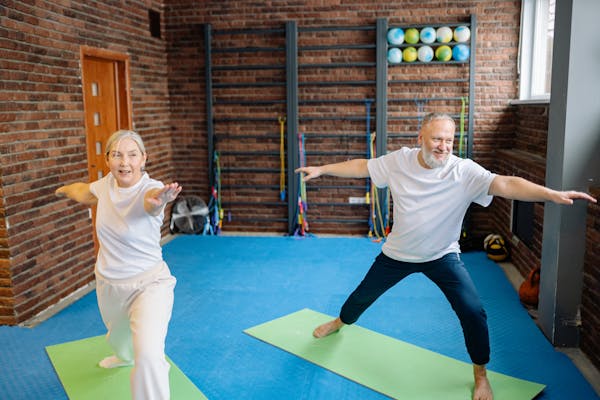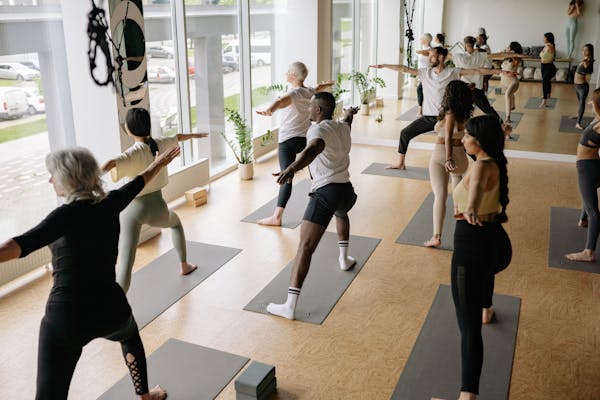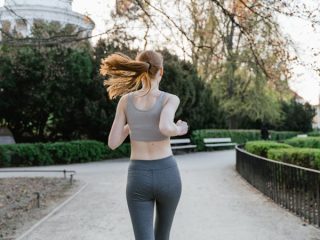
Becoming a senior citizen can be one of the best times of your life. After a lifetime of work, raising children or running a household, you finally have time for yourself; time to relax, vacation or just simply enjoy each day as it comes. However, many seniors feel held back by physical impairments such as aching muscles, arthritis, lack of energy or more serious conditions. Hence, Yoga classes for seniors are a superb way for older adults to contribute to their health and wellness. This article will tackle the yoga benefits for seniors, the breathing techniques, yoga styles, and enrollment tips for yoga classes.
Originating over 2,000 years ago in ancient India, yoga has transcended borders and age groups, becoming a global phenomenon. Its adaptability to various intensity levels makes it accessible to individuals of all abilities and life stages. Delving into the benefits of yoga for seniors, this article also offers insights into starting a yoga practice alongside recommended poses and breathing exercises.
Is yoga beneficial for older adults?
Absolutely. Aging demands continued physical activity, and yoga offers inclusive benefits regardless of mobility levels. Our senior yoga classes enhance strength, flexibility, breathing, and energy.
As aging progresses, prioritizing both physical and mental well-being becomes crucial. Yoga emerges as a gentle yet impactful exercise regimen, offering many health advantages for overall wellness.
Top 10 Yoga Benefits for Seniors
Did you know that yoga can greatly help ease many of these common ailments? Yoga is not for just the young, hip and flexible anymore. Many yoga techniques can be adapted for any age group or fitness level. There are also yoga classes for seniors that feature beneficial routines.
You may be wondering why should you try a new form of exercise, one that you may know little about, when you have been doing other forms of exercise your whole life such as jogging or walking. The truth is that there are many reasons yoga is perfectly suited for seniors:
Reduces Stress
Yoga is an excellent stress reducer, especially for seniors. Its blend of low-impact movements and breathing exercises has a calming effect on the body and mind. Studies indicate that older adults practicing yoga experience more significant stress reduction than other exercises. Yoga promotes physical well-being and enhances overall wellness by releasing neck, back, and shoulder tension.
Enhances Mood
Yoga combines stretching, breathing, movement, and meditation to enhance mood and overall well-being. It reduces physiological stress and inflammation and boosts GABA levels in the brain, promoting relaxation. Additionally, group participation in yoga classes provides social interaction, benefiting seniors who may feel isolated or anxious. Attending yoga sessions twice a week offers a simple yet effective way to lift mood, especially for seniors facing increased illness and isolation later in life.
Improves Posture
Yoga enhances posture, which is especially crucial for seniors facing posture-related risks. A study revealed improved spine flexibility in women over 50 after just weekly yoga sessions for five months. It aids posture by strengthening core muscles, supporting spinal alignment, and promoting bone health to combat osteoporosis. Moreover, yoga fosters body awareness, empowering seniors to stand tall confidently and improving posture.
Enhances Sleep Quality
Yoga might enhance sleep quality for seniors, combating issues like insomnia. Research indicates that regular yoga practice can improve sleep patterns within six months. The stretching and relaxation involved in yoga promote mental focus and physical exertion, resulting in reduced sleep latency, increased deep sleep, fewer disturbances, and overall better sleep efficiency.
Enhances Flexibility
Yoga can enhance flexibility, which is especially beneficial as joint flexibility typically declines with age. Gentle stretching motions in yoga promote greater flexibility. Research suggests that yoga is more effective than other forms of exercise in improving flexibility in older adults over time.
Reduces Falling Risks
Yoga can mitigate the risk of falls among seniors by enhancing balance and confidence.
Falls present a notable danger to the elderly independence and health, often resulting in emergency room visits. However, yoga’s slow, deliberate movements promote better balance, strengthening muscles and fostering confidence in movement. Emphasizing standing tall with balance, yoga helps seniors feel more secure in their mobility, reducing the fear of falling and enhancing overall safety in daily activities.

Improves Mobility
Enhanced mobility and decreased risk of falling are interconnected benefits of yoga for older adults. By improving balance and confidence, yoga promotes better mobility, addressing common issues like stiff muscles and joints often experienced by seniors. Through gentle stretching and muscle strengthening, yoga supports an improved range of motion, facilitating more effortless movement and navigation in daily activities.
Enhance Strength
Yoga can enhance strength through gentle yet effective techniques leveraging gravity and body weight. Studies in The Journals of Gerontology indicate that yoga is on par with other exercises for improving functional fitness, if not superior, owing to its holistic approach that combines physical exertion with mental focus and breathwork, promoting physical strength and mental rejuvenation.
Boosts Social Interactions
Yoga fosters social connections, which is crucial for combatting isolation in seniors. Classes offer a diverse community, facilitating friendships across age groups. Joining such groups not only encourages social engagement but also bolsters exercise adherence, serving as a motivating factor to stay active and connected.
Encourages Mindfulness
Yoga emphasizes mindfulness through breath awareness and self-reflection. You cultivate greater self-awareness by tuning into your body, thoughts, and emotions. This inward focus can extend to enhanced connections with others and the environment. Specific yoga practices also support brain health, potentially offsetting cognitive decline in seniors and promoting mental acuity with regular practice.
What are some beneficial yoga poses for seniors?
Here are some gentle yoga poses suitable for seniors or anyone seeking a mild stretch:
Cat-cow stretch
Start by positioning yourself in a tabletop stance, with both hands and knees on the mat. Inhale deeply, lifting your gaze towards the sky while arching your back. As you exhale, round your back and gaze between your hands. Alternate between these two poses, syncing your movements with your breath.
Downward-facing dog
Start by positioning yourself in a tabletop stance, with both hands and knees on the mat. Tuck your toes under and press down through your hands to lift your hips toward the sky. Maintain a slight bend in your knees, creating a diagonal line from your hands to your hips. Allow your head to hang between your shoulders as you slowly breathe.
Warrior II
Stand on your mat, feet wide apart. Stretch out your arms horizontally, with palms facing downwards. Pivot your front foot forward, bend the knee, and twist your upper body toward the front. Gaze over your front hand.
Tree pose
Stand with feet together. Shift weight to one foot, lifting an opposite foot to place the heel against the ankle. Stay here or raise your foot against the inner calf or thigh. Raise arms overhead or press palms together. Seniors with restricted mobility can also access chair yoga adaptations.
Yoga Breathing Techniques for Seniors
While yoga is frequently linked with bodily poses, it also encompasses meditation and breathwork. Here are some basic breathing exercises to explore:
Equal Breathing:
Take a breath in for four counts, then breathe out for four counts.
Belly Breathing:
Rest your hand on your belly, inhale deeply to feel it rise, and exhale slowly as it falls.
Alternate Nostril Breathing:
Close one nostril, inhale through the other, switch nostrils, and exhale. Repeat on both sides.
What’s the best way to begin practicing yoga?
There are numerous styles of physical yoga practice. Before starting yoga, consult your doctor if you have any health concerns. Adjust poses or avoid certain types of yoga. Here are additional tips to begin:
Select an Appropriate Yoga Style
Selecting the appropriate yoga style requires consideration of your level of fitness, health condition, and individual preferences. It’s essential to research various styles, such as Hatha, Vinyasa, or Yin, and consider trying introductory classes to determine which resonates best with you. Also, consult experienced instructors who can offer tailored recommendations based on your needs and goals.
Numerous yoga styles cater to varying preferences and intensity levels. Opting for gentle or restorative yoga provides multiple benefits and serves as an excellent entry point. These practices prioritize stretching and relaxation over vigorous activity or muscle-building, offering a gentle introduction to yoga.
Consider these various yoga styles to find one that suits your preferences:
-
Yin or restorative yoga:
Emphasizes stretching and relaxation over strength-building, often using props like pillows for support. It’s perfect for novices because of its mild nature.
-
Hatha yoga:
Characterized by a slower pace, it suits beginners seeking a relaxed practice.
-
Iyengar yoga:
Like yin yoga, it focuses on alignment and can be easily adapted using props like blankets or chairs, making it beginner-friendly.
-
Hot yoga:
Conducted in high-temperature environments to promote flexibility and release tight muscles. However, it may not be suitable for individuals with certain health conditions or sensitivity to heat, so consult with a doctor beforehand.

Find a Qualified Teacher or Enroll in Yoga Classes for Seniors
Now that you understand the benefits of yoga for seniors, you may be wondering why you should go to a yoga class. Yoga is a form of exercise you can easily do at home, but starting out as a senior yoga practitioner, you should not do yoga at home initially.
Seeking a certified yoga instructor experienced in working with seniors is essential for tailored guidance and pose modifications to suit individual needs.
Although senior yoga is not taxing on your body at all, just like any other form of exercise, there is the potential for injuries – especially if you’ve never tried any yoga poses before. It takes time and guidance to learn the proper yoga techniques and breathing patterns. For this you’ll need a well-qualified and patient yoga instructor.
Call a local yoga studio, and see if anyone of the teachers specializes in senior yoga. Also try the YMCA/YWCA, as these organizations often have beginning yoga sessions.
You can also try sites like Yoga Class Search or Yoga Finder. These sites break out class options by location and style.
Going to a senior yoga class can be incredibly fun and good for your health. You will likely meet other seniors who have the same skill level and experience as you do.
Conclusion:
Enjoy the benefits of yoga even as an older adult by enrolling in yoga classes nearest you. Yet, it is noteworthy to remember that consulting professional physicians would greatly help you decide on your body’s needs and exercise styles. Spend the best times of your life doing what you love by living healthy and getting a dose of exercise.














